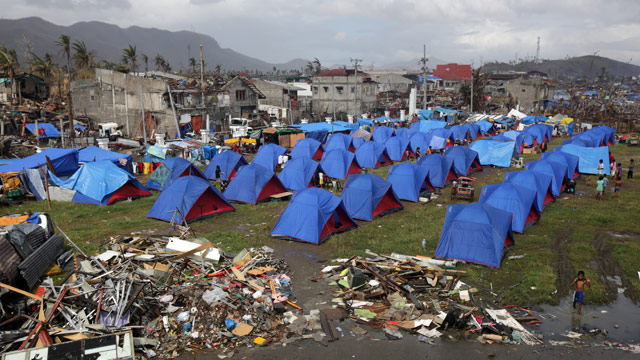SUMMARY
This is AI generated summarization, which may have errors. For context, always refer to the full article.

MANILA, Philippines – With inflows of shelter aid arriving in communities severely affected by Super Typhoon Yolanda (Haiyan), some survivors have begun to rise from the devastation to reconstruct their homes, and to rebuild their lives.
When the super typhoon swept through the Visayas, it destroyed houses and infrastructure, displacing 3.43 million people and damaging an estimated 1.1 million houses as of Monday, November 25, according to government estimates.
Of the total displaced, some 240,800 are living in 1,096 evacuation centers, the United Nations Office for the Coordination of Humanitarian Affairs (UNOCHA) said in its latest situation report. The death toll has reached over 5,000, and around 1,600 people are missing. (READ: PH typhoon death toll now at least 5,235)
In Tacloban City and Guiuan, two of the hardest hit areas, some have begun rebuilding their houses, according to United Nations High Commissioner for Refugees (UNHCR) public information officer Vivian Tan.
In Tacloban, some of the roads have been cleared, and markets are slowly coming back out. There are now people selling fruits and meat in stalls on the street.
“There seems to have been a shift in the past weeks. I’ve seen people getting back on their feet. Of course, they’re a long way off but I’m starting to see signs of people repairing their homes, looking forward to repairing their roofs,” Tan said.
Makeshift homes
To help survivors in reconstruction and recovery, the UNHCR and the International Organization for Migration (IOM) have delivered equipment, tools and other non-food supplies for setting up temporary shelter and repairing houses. (READ: UN OCHA reports: Aid agencies deliver relief to Haiyan victims)
In an update issued Friday, November 22, the UNHCR said it has distributed aid to at least 23,000 affected people in Tacloban, Tanauan and Ormoc. These include tents, blankets, plastic sheets, hygiene kits, mosquito nets, kitchen sets and sleeping mats.
The shelter kits and tools have helped survivors create makeshift homes. They have also decongested some overcrowded evacuation centers, Tan said.
The IOM has also coordinated with local authorities in setting up mass shelter for thousands of people in Tacloban City, with additional shelter kits scheduled for delivery. IOM’s target is to set up at least 29 evacuation centers that will provide refuge for around 56,000 people across affected areas.
“We have brought into this picture a number of people called camp managers. These are IOM staff who are highly experienced in setting up camps for the displaced,” IOM’s media correspondent Leonard Doyle said.
Other organizations are also distributing shelter kits to families in affected areas. (READ: Emergency shelter kits sent to Bantayan Island)
Logistical constraints
For the UNHCR, logistical constraints and limited access to communities initially challenged aid distribution. “Tacloban has a lot of UN and NGOs working there, and distribution has been robust. In Guiuan, we have been sending items, but it is a bit remote and harder to get there,” Tan said.
She also said airports in the beginning were congested because of incoming flights carrying aid, but this problem was eventually resolved.
UNHCR’s aid will continue to focus on critically hit areas: Leyte (especially Tacloban and Ormoc), Guiuan, the east coast of Samar Province and Panay Island (particularly Roxas).
The scope of aid distribution still has not been able to reach faraway areas. Assessment missions are ongoing as the agency is gradually expanding relief efforts to cover more ground and to identify more rural areas in need.
“There has been a very conscious decision to move beyond Tacloban to reach remote areas,” said Tan. “So far we have presence in Tacloban, Guiuan and Ormoc, and a logistics team in Cebu. We’re currently having a small team in Roxas assessing the situation there, to see what presence is needed there.”
Transition from past emergencies
The IOM meanwhile had to undergo transition, moving some of their staff to Tacloban City and Roxas City. Some of the organization’s camp managers had been working to help victims in the Zamboanga siege and in disasters like the recent Bohol earthquake and Typhoon Pablo.
“No question that this is an enormous crisis, and the sheer scale of it boggles the imagination,” Doyle said. “And then you add to that not only how these people lost so much but also finding a way to get back on their feet. The crisis is enormous but the response has to be all the more impressive.”
The UNHCR and the IOM are part of the cluster coordination system under the UNOCHA, which coordinates humanitarian and relief efforts from different UN and international agencies. (READ: UN: Yolanda (Haiyan) victims need $301M) – Karen Liao/Rappler.com
Add a comment
How does this make you feel?
There are no comments yet. Add your comment to start the conversation.